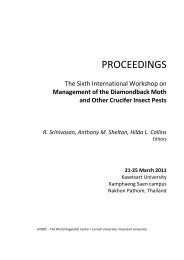Leguminous Vegetable Cultivation and Seed Production S ...
Leguminous Vegetable Cultivation and Seed Production S ...
Leguminous Vegetable Cultivation and Seed Production S ...
You also want an ePaper? Increase the reach of your titles
YUMPU automatically turns print PDFs into web optimized ePapers that Google loves.
37 0 GREEN MANURE IN RICE FARMING<br />
Table 4, Equilibrium moisture content of soybean at 25 0 C at 30-95% relative<br />
humidity (RH) (Roberts <strong>and</strong> Roberts 1972).<br />
Equilibrium moisture content at given RH<br />
1 0% 30% 45%<br />
60% 75%<br />
95%<br />
4.3 6,5 7.4 9.3 1 3.1 18.8<br />
moisture content, it can be stored for 3 yr. At 20-30 °C, seed with 13-18% moisture<br />
content will remain viable for less than a year (Toole <strong>and</strong> Toole 1946). Under<br />
tropical conditions, high initial quality soybean seeds at 9-9.5% moisture content can<br />
be safely stored 9 mo at 20-25 °C <strong>and</strong> 50-60% RH (Gregg 1982). Most AVRDC<br />
breeding materials with good initial seed quality <strong>and</strong> 9-10% moisture content are<br />
stored at 20-24 °C <strong>and</strong> 55-60% RH. The majority of the entries stored under these<br />
conditions retained more than 80% viability for at least 2 yr. Similar storage<br />
conditions are suitable for mungbean.<br />
If storage conditions have a higher RH, there is no need to dry the seed to less<br />
than equilibrium moisture content. At 45% RH or lower, seed should be dried to<br />
7.4% moisture content or lower. At 60% RH, drying the seed to 9% moisture will<br />
suffice. Soybean seed moisture content at 25 °C with different relative humidity<br />
levels are given in Table 4.<br />
The usual rule of thumb for storage conditions for the short term is percent RH<br />
<strong>and</strong> degrees Fahrenheit totaling 100 or less (James 1961).<br />
The viability of soybean is determined using an age index concept.<br />
Age index (AI) = months in storage X Io'""( X 10<br />
0.06451<br />
Where MC = moisture content (%), T = temperature (°C), <strong>and</strong> months in storage =<br />
Log AI-0.143M C-0.0645T.<br />
Fungi activity during storage below 75% RH is very low; below 62% RH, all<br />
storage fungi are completely inactive (Roberts 1972a). Below 60% RH, storage<br />
insects are inactive. Because rnungbean weevil is a serious storage pest, it is<br />
.important to maintain RH below 60% <strong>and</strong> seed moisture content below 8% (Roberts<br />
1972a).<br />
The minimum germination required for seed certification varies among<br />
countries. For soybean, it is 80% in the US, but many seedmen dem<strong>and</strong> 90%<br />
(Tekrony et al 1978). In India, it is 70%. For mungbean, minimum germination in<br />
India is 75% (Agrawal 1980).<br />
Under ambient conditions, mungbean appears to be storable longer than<br />
soybean (Table 5). Traditional mungbean varieties appear to have a high proportion<br />
of hard seeds, but hard seededness decrease with age in storage. Mungbean seed<br />
loses hard seededness with a year (Pathwardhan 1927).<br />
During domestication, the hard seededness character was selected out. It<br />
appears probable that this trait in mungbean can be used in breeding for good seed<br />
quality (B. C. Irnrie, pers. comm.). Soon after harvest, hard-seeded rnungbean<br />
germination is low, but it improves with storage (Rajasekara Mudaliar <strong>and</strong>
















